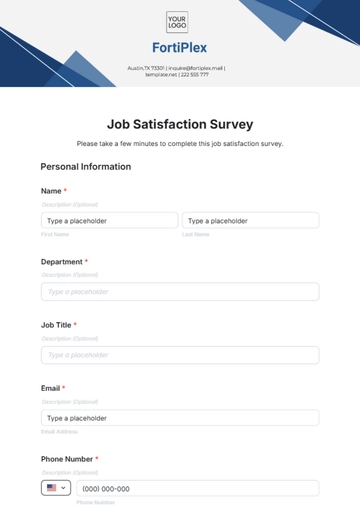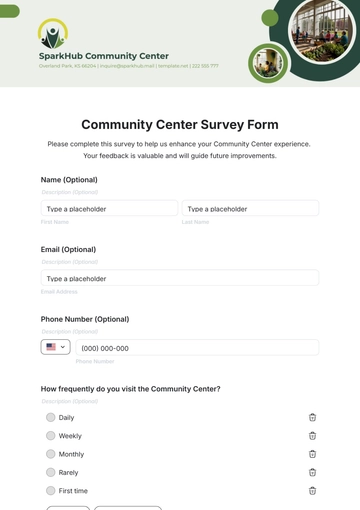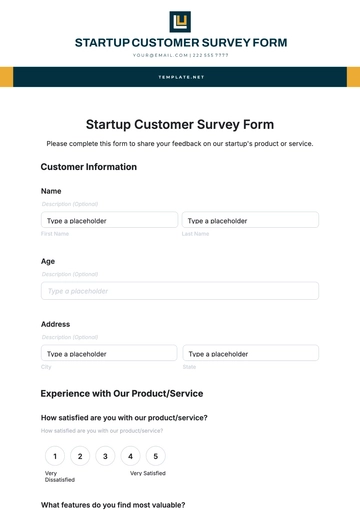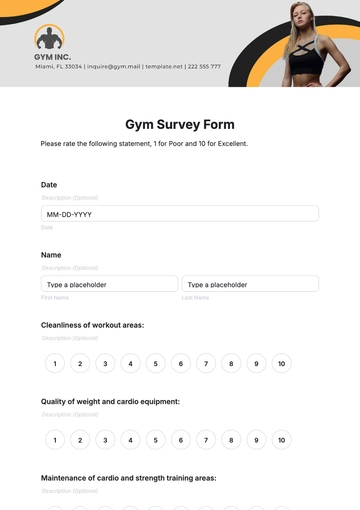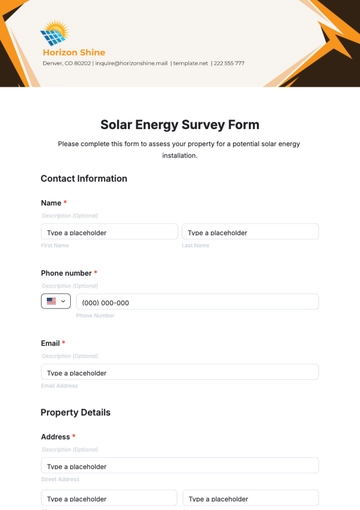Free School Survey Report

I. Introduction
A. Purpose of the Survey
The primary purpose of this survey is to comprehensively assess the various aspects of [Your Company Name], including academic performance, school climate, facilities, resources, and stakeholder satisfaction. The results aim to provide actionable insights that will help improve the quality of education and overall school environment. By identifying strengths and areas for improvement, the survey will inform strategic planning and guide the allocation of resources. Additionally, it will serve as a tool for engaging stakeholders in the continuous improvement process.
B. Background Information about the School
[Your Company Name], established in [Year], is located in an urban area and serves approximately 1,200 students in grades 9-12. The school has a diverse student population, with students coming from various socio-economic and cultural backgrounds. Over the years, the school has built a reputation for academic excellence, robust extracurricular programs, and strong community involvement. The administration is committed to maintaining high standards and fostering a safe, inclusive, and supportive learning environment.
C. Methodology
Survey Design
The survey was designed collaboratively by the school administration, teachers, and an external research firm, incorporating best practices in educational research. It included a mix of quantitative and qualitative questions to capture a wide range of insights. The survey was structured into sections covering academics, school climate, facilities, resources, and stakeholder engagement. The questions were piloted with a small group of respondents to ensure clarity and reliability.
Data Collection Methods
The survey was administered online using a secure platform to ensure data privacy and confidentiality. It was available for two weeks, with reminders sent periodically to encourage participation. Both English and Spanish versions of the survey were provided to accommodate the diverse linguistic needs of the community. In addition, paper copies were made available for those without internet access.
Respondent Demographics
A total of [00] responses were collected, representing a response rate of [00]%. The respondents included [00] students, [00] parents, [00] teachers, and [00] staff members, reflecting a broad spectrum of the school community. The demographic breakdown ensures that the survey results are representative and inclusive of various perspectives. Efforts were made to ensure proportional representation across different grades, departments, and demographic groups.
II. Executive Summary
A. Key Findings
The survey results indicate high levels of satisfaction with the academic curriculum and teacher effectiveness, with [00]% of respondents rating these areas positively. However, there are notable concerns regarding school safety, with [00]% of students expressing they do not feel safe. Facilities maintenance also emerged as a significant issue, with [00]% of parents dissatisfied with the current state of the school’s infrastructure. Stakeholder engagement, particularly parental involvement, was identified as an area needing substantial improvement.
B. Major Recommendations
Based on the findings, the following major recommendations are proposed: First, enhance safety protocols and implement a comprehensive anti-bullying program to address student concerns. Second, invest in upgrading school facilities to improve the learning environment and overall satisfaction. Third, develop strategies to increase parental engagement, such as regular communication updates and involvement opportunities. Lastly, continue to support and expand professional development for teachers to maintain high instructional quality.
III. Survey Demographics
A. Respondent Overview
Number of Respondents
Respondent Type | Number | Percentage |
|---|---|---|
Students | [00] | [00]% |
Parents | ||
Teachers | ||
Staff |
The survey received a total of [00] responses, with students making up the largest group of respondents at [00]%. Parents contributed [00]% of the responses, providing valuable insights into family perspectives. Teachers accounted for [00]% of the respondents, offering critical views on academic and operational aspects. Staff members represented [00]% of the total responses, highlighting areas such as facilities and support services.
B. Representation
Grade Levels
Responses were well-distributed across grades 9-12, ensuring a balanced perspective from all grade levels. This distribution helps to identify trends and issues that may be specific to certain grades. For example, seniors expressed higher satisfaction with college readiness programs compared to freshmen. Conversely, freshmen highlighted the need for better orientation and support during their transition to high school.
Departments
Teachers and staff from all departments, including Math, Science, English, Social Studies, Arts, and Physical Education, participated in the survey. This comprehensive participation ensures that the survey findings reflect the diverse needs and challenges across different academic and extracurricular areas. For instance, Science teachers noted a need for updated lab equipment, while Arts teachers emphasized the importance of funding for supplies and performances. Additionally, Physical Education staff highlighted the necessity for improved gym facilities and resources.
Response Rates
The overall response rate was [00]%, with the highest participation rate observed among students at [00]%. The parent response rate was [00]%, which, while significant, indicates room for increased engagement. Teachers and staff had response rates of [00]% and [00]%, respectively, demonstrating strong but improvable participation. Efforts to increase response rates in future surveys could include additional reminders and incentives for participation.
IV. Academic Performance
A. Student Achievement Data
Test Scores
Subject | Average Score | State Average |
|---|---|---|
Mathematics | [00]% | [00]% |
English | ||
Science |
Grades
The majority of students ([00]%) reported grades of B or higher across subjects, indicating strong overall academic performance. A further breakdown shows that [00]% of students achieved A grades, while [00]% received B grades. This positive grade distribution underscores the effectiveness of instructional strategies and student support systems. However, [00]% of students reported grades of C or lower, suggesting areas where additional academic support may be needed.
Graduation Rates
The current graduation rate is [00]%, which is significantly above the state average of [00]%. This high graduation rate reflects the school’s success in retaining and supporting students through to the completion of their studies. Efforts such as personalized academic counseling and targeted intervention programs have contributed to this achievement. Continuous monitoring and support for at-risk students remain a priority to maintain and improve this rate.
B. Teacher Effectiveness
Instructional Quality
[00]% of students and parents rated the quality of teaching as excellent or good. Teachers are praised for their subject matter expertise, engagement techniques, and commitment to student success. Students particularly appreciate the interactive and supportive classroom environment. Parents highlight the teachers’ responsiveness and dedication to addressing individual student needs.
Professional Development
[00]% of teachers reported that professional development opportunities are adequate and beneficial. Regular workshops and training sessions are provided to keep teachers updated with the latest educational strategies and technologies. Teachers expressed a desire for more specialized training in areas such as differentiated instruction and advanced technology integration. Continued investment in professional development is essential to maintain high instructional standards.
C. Curriculum Adequacy
Relevance
[00]% of students feel that the curriculum is relevant to their future goals, indicating a strong alignment with college and career readiness. Students appreciate courses that offer practical skills and knowledge applicable to real-world scenarios. Elective courses, particularly in technology and business, received high marks for their relevance. Ensuring that all courses maintain this level of relevance is critical for student engagement and success.
Rigor
[00]% of parents believe the curriculum challenges their children appropriately, balancing difficulty with support. The school offers a range of Advanced Placement (AP) and honors courses, which are well-regarded by both students and parents. However, some parents and students suggested a need for additional support in these more rigorous courses. This feedback highlights the importance of providing adequate resources and support systems to help all students succeed.
V. School Climate
A. Student Morale and Well-being
Engagement
[00]% of students feel engaged in their classes, finding the material interesting and the teaching methods effective. Interactive and project-based learning approaches were particularly appreciated. However, [00]% of students reported feeling disengaged, citing reasons such as uninteresting content or lack of motivation. Addressing these concerns through differentiated instruction and varied teaching methods could improve overall engagement.
Emotional Support
[00]% of students report having access to adequate emotional support through counselors and peer support programs. The availability of mental health resources is valued, but some students indicated long wait times for counseling services. Enhancing the capacity and accessibility of these services is essential to meet student needs. Additionally, promoting a school culture that encourages seeking help can further support student well-being.
B. Teacher and Staff Morale
Job Satisfaction
[00]% of teachers and staff are satisfied with their jobs, enjoying their roles and the school environment. Positive aspects mentioned include supportive administration, professional development opportunities, and collaborative work culture. However, [00]% of respondents expressed concerns about workload and stress levels. Addressing these concerns through workload management and wellness programs could enhance overall job satisfaction.
Professional Relationships
[00]% of staff report positive professional relationships with colleagues, fostering a collaborative and supportive work environment. Teamwork and mutual respect are highlighted as key strengths. Opportunities for peer mentoring and collaborative planning were particularly appreciated. Enhancing these opportunities can further strengthen professional relationships and improve overall school climate.
C. Safety and Bullying
Incidence Reports
In the past year, there were [00] reported incidents of bullying and [00] incidents of physical fights. While these numbers are relatively low, they indicate a need for continued focus on creating a safe school environment. Efforts such as anti-bullying campaigns and conflict resolution programs are in place but may require enhancement. Regular training for staff and students on these issues is recommended to further reduce incidents.
Perceptions of Safety
[00]% of students feel safe at school, suggesting that there is room for improvement in safety measures. Specific concerns include isolated areas on campus and incidents of bullying. Addressing these issues through increased supervision and preventive programs is crucial. Engaging students in safety initiatives can also help build a more secure school environment.
D. Inclusivity and Diversity
Representation
The student body is diverse, with representation from various ethnic and socio-economic backgrounds. Efforts to celebrate this diversity through cultural events and inclusive practices are ongoing. However, some students and parents feel that more can be done to ensure equitable treatment and opportunities for all. Continued focus on diversity training and inclusive policies is essential to support all students.
Inclusiveness Initiatives
[00]% of respondents believe the school is inclusive and promotes diversity through various initiatives. Programs such as cultural awareness weeks and diversity clubs are well-received. However, there is a call for more proactive measures to address any instances of discrimination or exclusion. Strengthening these initiatives can foster a more inclusive and welcoming school environment for all.
VI. Facilities and Resources
A. Quality of Educational Materials
Textbooks and Supplies
[00]% of teachers report that textbooks and supplies are up-to-date and sufficient for classroom needs. However, some subjects, particularly in the sciences, have highlighted the need for more modern resources. Ensuring regular updates and adequate funding for educational materials is crucial. Additionally, providing digital resources can supplement traditional textbooks and enhance learning.
Technological Resources
[00]% of students have access to necessary technological resources, including computers and internet connectivity. The school has made significant investments in technology to support digital learning. However, there are occasional issues with equipment maintenance and availability during peak times. Continued investment in technology infrastructure and support is recommended to address these challenges.
B. Physical Infrastructure
Classroom Conditions
[00]% of respondents feel that classroom conditions need improvement, particularly regarding temperature control and seating arrangements. Inadequate heating and cooling systems have been reported as significant issues. Regular maintenance and upgrades to classroom infrastructure are necessary to create a conducive learning environment. Additionally, ergonomic seating arrangements can enhance comfort and productivity.
Maintenance and Upkeep
[00]% of parents are dissatisfied with the school's maintenance, citing concerns such as cleanliness and the condition of bathrooms and common areas. Regular maintenance schedules and prompt attention to reported issues are essential to address these concerns. Engaging the school community in maintenance awareness and responsibility can also improve overall upkeep.
C. Extracurricular Activities
Availability
A wide range of extracurricular activities is available, including sports, arts, and academic clubs. However, participation rates vary, with some activities more popular than others. Ensuring a balanced and diverse offering that caters to various interests can enhance student engagement. Additionally, promoting lesser-known activities can increase participation and provide more opportunities for student involvement.
Participation Rates
Activity Type | Participation Rate |
|---|---|
Sports | [00]% |
Arts | |
Academic Clubs | |
Other Activities |
VII. Parental and Community Involvement
A. Parental Engagement
Communication Effectiveness
[00]% of parents feel the school communicates effectively with them through newsletters, emails, and parent-teacher meetings. However, there are suggestions for more frequent updates and real-time communication tools. Implementing a comprehensive communication strategy that includes digital platforms can enhance engagement. Ensuring that communication is accessible in multiple languages can also improve effectiveness.
Participation in School Activities
[00]% of parents participate in school activities regularly, including attending meetings, events, and volunteering. While this indicates a decent level of involvement, there is room for improvement. Encouraging more parents to engage through flexible scheduling and diverse opportunities can boost participation. Providing clear information on how parents can get involved is also important.
B. Community Support
Partnerships
The school has partnerships with local businesses and organizations, which provide resources and support for various programs. These partnerships have been beneficial in enhancing educational and extracurricular opportunities. However, there is potential for growth in this area by exploring new collaborations. Strengthening existing partnerships and establishing new ones can further support the school’s mission.
Volunteerism
[00]% of parents volunteer at the school at least once a year, contributing to events, classroom activities, and committees. Increasing volunteer opportunities and making them more accessible can encourage greater involvement. Recognizing and appreciating volunteers can also motivate more parents to participate. Building a strong volunteer community can enhance the overall school environment and support student success.
VIII. Recommendations
A. Immediate Actions
Addressing Critical Issues
Enhance safety protocols and implement a comprehensive anti-bullying program to address student concerns. This includes increasing supervision in vulnerable areas, conducting regular safety drills, and providing clear reporting mechanisms. Additionally, training staff and students on recognizing and preventing bullying can create a safer school environment.
Short-term Goals
Begin immediate repairs and maintenance of school facilities to address concerns about classroom conditions and cleanliness. Prioritize issues such as heating and cooling systems, bathroom facilities, and common areas. Establishing a regular maintenance schedule and involving the school community in reporting problems can ensure timely resolutions.
B. Long-term Strategies
Strategic Planning
Develop a five-year strategic plan focusing on curriculum development, facility upgrades, and increased parental engagement. This plan should include clear goals, timelines, and accountability measures. Engaging stakeholders in the planning process can ensure that the strategies align with the needs and priorities of the school community.
Continuous Improvement
Establish a continuous improvement committee to monitor progress and make ongoing adjustments. This committee should include representatives from all stakeholder groups, including students, parents, teachers, and staff. Regularly reviewing data and feedback can help identify areas for improvement and ensure that initiatives remain effective and relevant.
IX. Conclusion
A. Summary of Findings
The survey results highlight both strengths and areas for improvement within [Your Company Name]. While academic performance and teacher effectiveness are commendable, attention is needed in areas such as school safety, facilities, and parental engagement. Implementing the recommended actions can address these concerns and enhance the overall school environment.
B. Acknowledgments
We would like to thank all survey participants, including students, parents, teachers, and staff, for their valuable input. Special thanks to the survey design team and external consultants for their expertise and support. Your feedback is crucial in our ongoing efforts to improve [Your Company Name] and provide the best possible educational experience for our students.
- 100% Customizable, free editor
- Access 1 Million+ Templates, photo’s & graphics
- Download or share as a template
- Click and replace photos, graphics, text, backgrounds
- Resize, crop, AI write & more
- Access advanced editor
Manage school surveys effortlessly with Template.net's editable School Survey Report Template. This customizable template allows you to tailor content to your needs using our AI Editor Tool. Ideal for capturing detailed insights, it simplifies the survey process, ensuring comprehensive and professional reports every time. Boost your school's evaluation with ease and precision.











